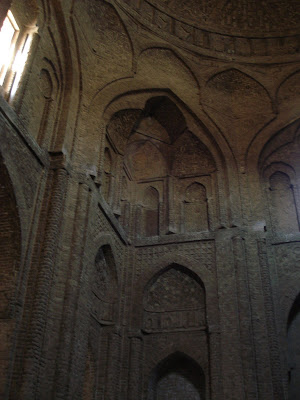Approaching the North Dome
My fresh knowledge about the history of Esfahan’s Friday Mosque, which I had acquired before traveling to Iran, has been posted as well. While reading Oleg Grabar’s text is, in fact, a great pleasure, the black-and-white pictures of the mosque do not give a good impression of its grandeur (although Professor Grabar would argue that I am still watching the architecture with a tourist’s eye). In the coming weeks I plan to describe the different parts of the mosque mainly based on Grabar’s expert descriptions, and document it with my new pictures. Different parts of the mosque are constantly being restored and tile decorations are replaced. But the contemporary artisans have been meticulous. I suppose that the original tile patterns, in certain areas dazzling tessellations, have largely survived for centuries.


Why is the North Dome of the mosque so mysterious? First, it is perfect. It has survived dozens of severe earthquakes since it had been constructed in 1088 CE, only two years after the South Dome (which can be seen on the first picture) had been built. The southern dome is not really elegant. When constructed, it was regarded the largest dome in the Islamic world. It definitely belongs to the Seljuq mosque. The North Dome, which was commissioned by Taj al-Mulk, an arch enemy of the ingenious vizier Nizam al-Mulk, seems to be excluded from the place of worship. Four years later, Malik Shah, the sultan who commissioned the south dome, died and Nizam al-Mulk was assassinated by the Hashashin sect.
Omar Khayyam, the great medieval mathematician who was born in Nishapur in Khorasan, lived in Esfahan under Nizam and Malik Shah. He was called to the city to build an observatory which has never been found. Without any proof, it is widely believed that Khayyam was involved in the perfect construction of the dome. Mathematician Alpay Özdural presented a fine argument about the special right triangle described by Omar Khayyam (and most probably not the Golden Section, as Oleg Grabar argues), which seem to be present all over the North Dome of the Great Mosque, the Gunbad-e Khaki, or earthly dome. Is it possible that the North Dome is in fact Omar Khayyam's observatory? The last picture has been taken from Özdural's original publication. You may find much more information here.
While wandering through the vaults in the northern parts of the Great Mosque, the looks to the ceiling with its numerous brick cupolas and the plenty of inclined columns are quite breathtaking. Amazingly, I met young and older Esfahanians, who were visiting the site for the first time.

















Comments